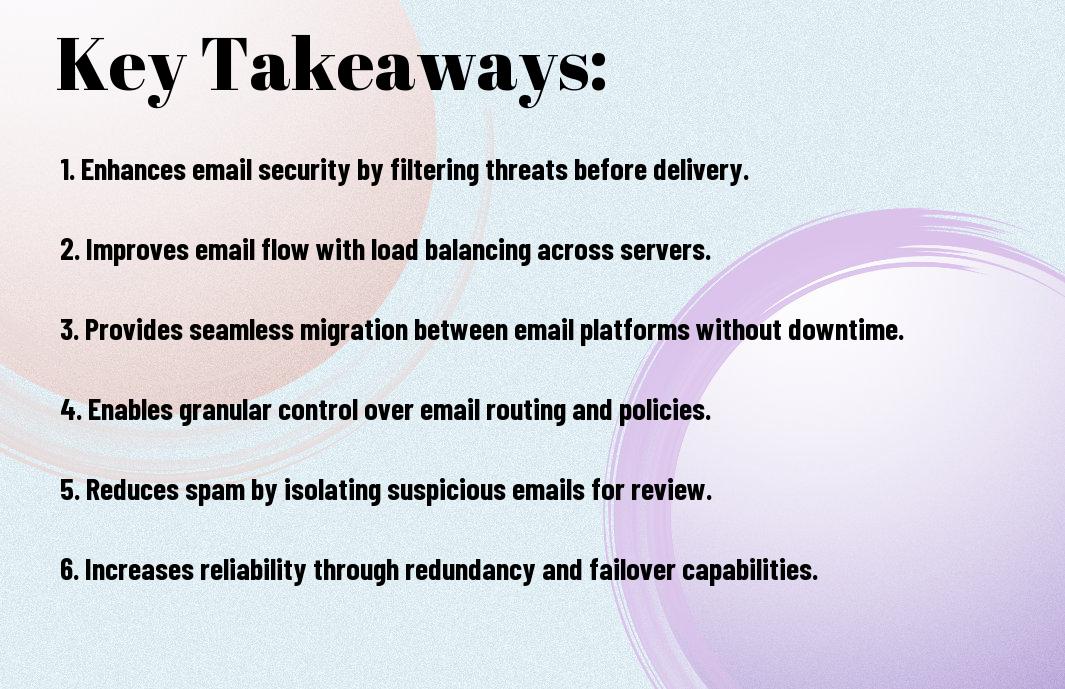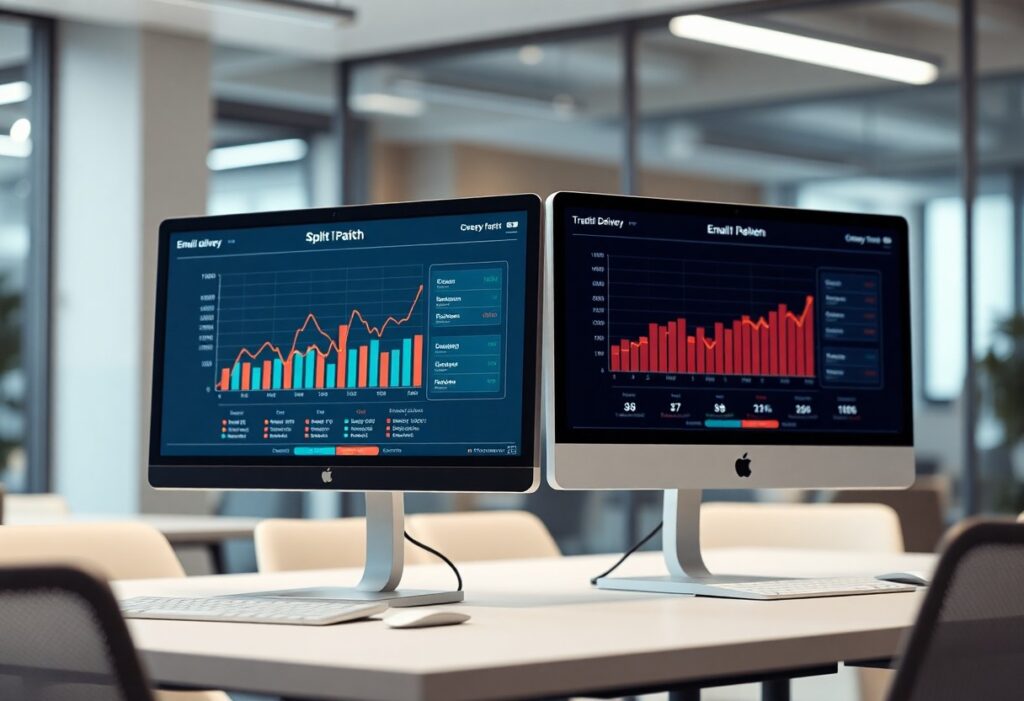Most businesses overlook the strategic benefits of split email delivery, which can significantly enhance your email marketing campaigns. By dividing your email list and tailoring messages for each segment, you can improve engagement rates, optimize deliverability, and fine-tune your overall strategy based on real-time performance data. In this blog post, you’ll discover the pivotal advantages of implementing split email delivery and how it can propel your email marketing efforts to new heights, ensuring you connect more effectively with your audience.

Key Takeaways:
- Enhanced Deliverability: Split email delivery helps ensure messages reach their intended recipients by minimizing the risk of being flagged as spam.
- Improved Engagement Metrics: By targeting segments of the audience with tailored content, businesses can see increased open and click-through rates.
- Robust Performance Insights: Analyzing different email variations can uncover valuable insights into audience preferences and behavior.
- Optimized Server Resources: Distributing email loads across multiple servers can enhance performance and reduce server strain during high-volume campaigns.
- Increased Flexibility: With the ability to test and adapt strategies in real-time, marketers can refine their messaging based on immediate feedback and results.

Unpacking the Mechanics of Split Email Delivery
Understanding split email delivery offers deeper insights into its deployment and functionality. At its core, this method involves sending email campaigns concurrently to different segments, allowing you to monitor performance variations across these groups. By doing so, you can tailor content, timings, and subject lines to maximize engagement and open rates, ultimately driving better results for your marketing efforts.
How Split Email Delivery Works
In practice, split email delivery entails creating multiple versions of an email and dispatching them to distinct audience segments. For instance, you might modify the subject line while keeping the body content consistent. By analyzing which version generates more clicks or conversions, you can optimize future campaigns based on real-time data, making each communication more effective.
Key Technical Considerations
Several technical elements are vital to ensure the success of your split email delivery strategy. Segmentation, email tracking, and A/B testing tools must be correctly integrated into your email platform. Furthermore, maintain a clean and comprehensive database to effectively categorize your audience and avoid potential deliverability issues, which could impact your overall performance metrics.
Segmentation tools should allow for dynamic adjustments based on user behavior or demographic characteristics, giving you flexibility in targeting different audience groups with relevant messages. Additionally, robust email tracking solutions help monitor key performance indicators (KPIs) like open rates, click-through rates, and conversion rates. Using reliable A/B testing frameworks facilitates data-driven decision-making, refining your campaign strategies based on clear, evidence-backed results, ultimately leading to enhanced email marketing success.

Maximizing Engagement: The Power of Personalization
Personalization transforms your email campaigns into targeted communications that resonate with your audience. By tailoring your messaging to your recipients’ interests and preferences, you can significantly enhance engagement rates. Split email delivery enables you to test various personalized approaches simultaneously, identifying which resonates most effectively with different segments of your audience.
Tailoring Content Based on Segmentation
Segmentation allows you to categorize your audience based on various criteria such as demographics, purchasing behavior, or engagement levels. By creating tailored content for each segment, you can address specific needs and preferences, fostering a stronger connection. For instance, sending targeted offers to loyal customers versus new subscribers promotes relevance and encourages action, ultimately driving conversions.
Timing and Frequency: The Strategic Approach
Strategic timing and frequency are vital in maximizing engagement through email delivery. Analyzing past campaign data helps identify optimal send times for your audience, ensuring emails land in their inbox when they are most likely to engage. Additionally, experimenting with different frequencies prevents overwhelming your recipients while keeping your brand top-of-mind.
Incorporating advanced analytics can lead to outstanding results in timing and frequency. For example, if your data shows that emails sent on Tuesdays at 10 AM yield the highest open rates, you can prioritize this timing strategy. Tracking engagement metrics post-campaign allows you to refine your approach and discover the perfect balance between maintaining engagement without causing annoyance. Utilizing split email delivery underlines this strategy, as it facilitates A/B testing of send times and frequencies to determine what works best for your audience segments. By making informed decisions, you enhance the overall impact of your email marketing efforts.
Performance Metrics That Matter
Measuring the success of your split email delivery strategy involves tracking key performance metrics. These metrics not only provide insights into how your audience is engaging with your content but also inform future campaigns. By concentrating on imperative data points like open rates, click-through rates, and overall conversion rates, you can effectively refine your email marketing strategies to enhance engagement and ROI.
Tracking Open Rates and Click-Through Rates
Open rates and click-through rates (CTR) serve as direct indicators of how well your email campaigns are resonating with your audience. High open rates suggest compelling subject lines, while CTR reveals the effectiveness of your content and call-to-action. Using A/B testing during split email delivery allows you to fine-tune these elements by experimenting with different formats and messages to see which ones drive better engagement.
Analyzing Conversion and ROI
Converting email recipients into customers is the ultimate goal of your campaigns, and analyzing conversion rates alongside ROI provides valuable insights. By employing split email delivery, you can discern which messaging strategies yield the highest conversion rates and determine the costs associated with acquiring new customers through each approach. This data enables you to allocate your marketing budget more efficiently.
Examining conversion and ROI goes beyond just numbers; it requires a comprehensive understanding of customer behavior. For instance, if you notice that one segment converts at a significantly higher rate after receiving a specific email variant, it may highlight a unique pain point or interest that resonates with that audience. Tools like Google Analytics or email tracking software can further break down revenue generated per email campaign, aligning your marketing efforts with fiscal performance. With accurate metrics at your fingertips, you can make informed adjustments to improve campaign outcomes over time.
Navigating the Challenges of Implementation
Implementing split email delivery can present several challenges that may impede your success. From technical hurdles and data integration to adjustments in workflows, these obstacles can affect the efficiency of your strategy. Recognizing and addressing these issues early in the process not only protects the integrity of your campaigns but also ensures a smoother transition for your team and your audience.
Common Obstacles to Successful Split Delivery
Technical difficulties often arise when configuring systems to support split delivery, including email client compatibility and deliverability issues. Data segmentation can become complex if your existing customer database lacks proper categorization. Additionally, aligning team members on the new process may lead to confusion or resistance, slowing down implementation.
Strategies for Easing the Transition
To facilitate a smoother transition to split email delivery, start by providing comprehensive training sessions for your marketing and technical teams. Implementing a phased rollout of split delivery allows for testing on a smaller scale before full implementation, which can catch potential issues early. Regularly soliciting feedback from your team throughout this process helps you make necessary adjustments efficiently.
Engaging your audience during the transition can also minimize disruptions. Send out communication explaining the changes and the benefits they can expect. Use feedback forms to gauge their experience with the changes, creating a sense of involvement and trust in your brand. By continuously refining your strategy based on team and customer input, you can effectively navigate challenges and optimize your split email delivery system for the best outcomes.
The Future Landscape of Email Marketing
The world of email marketing is poised for transformation as brands embrace innovative practices like split email delivery. As consumer preferences evolve, leveraging personalization, segmentation, and automated workflows will be paramount. The integration of advanced AI tools will enhance your ability to analyze data and optimize campaigns, allowing for real-time adjustments that resonate more effectively with your audience. By foreseeing these shifts, you can position your marketing strategies for long-term success.
Emerging Trends Influencing Split Delivery
Staying ahead of emerging trends is key to refining your split email delivery strategy. With increasing emphasis on user experience and engagement, you’ll want to leverage behavioral data to tailor your messages effectively. For instance, incorporating interactive elements into emails can boost click-through rates, encouraging recipients to engage more actively with your content. This adaptability to trend shifts enables you to remain relevant amidst changing consumer behaviors.
Adapting to Technological Advances
Technological advancements are reshaping email marketing strategies, necessitating your agility in adapting to new tools and platforms. Automation software, predictive analytics, and machine learning models allow for deeper insights into audience behaviors, enabling refined targeting. Additionally, embracing platforms that seamlessly integrate with CRM systems can streamline your workflow, enhancing efficiency and coordination when managing split email delivery campaigns. This not only improves campaign performance but also cultivates stronger customer relationships over time.
Leveraging automation tools can provide significant advantages, reducing the manual workload associated with A/B testing. For instance, platforms like HubSpot or Mailchimp enable you to automatically adjust your campaigns based on real-time performance metrics. Employing machine learning algorithms helps you predict customer preferences, ensuring your email content remains relevant and impactful. These technological advancements are not just tools; they represent a paradigm shift in how you interact with your audience, setting the foundation for future campaigns grounded in data-driven insights.
Conclusion
Hence, by implementing split email delivery, you can significantly enhance your email marketing effectiveness. This strategy allows you to test different content and delivery times, leading to improved open and click-through rates. Furthermore, you gain valuable insights from real-time analytics, enabling you to tailor your campaigns to better meet your audience’s preferences. Ultimately, adopting split email delivery can not only optimize your outreach but also elevate your overall marketing performance, giving you a competitive edge in the digital landscape.
FAQ
Q: What is split email delivery and how does it work?
A: Split email delivery is a method where emails sent from a single campaign are divided, with different segments being sent through multiple Mail Transfer Agents (MTAs) or email service providers (ESPs). This approach allows for better management of email traffic and can enhance deliverability by utilizing the strengths of various providers.
Q: What are the primary benefits of implementing split email delivery?
A: One of the main benefits of split email delivery is improved deliverability rates. By using multiple MTAs, you can potentially reach more inboxes while avoiding the pitfalls of a single provider’s limitations. Additionally, this strategy enhances tracking and analytics capabilities, allowing for better insights into what resonates with your audience. It can also provide redundancy; if one provider encounters issues, the others can compensate, ensuring that your campaigns continue smoothly.
Q: How does split email delivery contribute to better email engagement?
A: By splitting your email delivery, you can test performance across different platforms, adjusting your strategy based on what garners the highest engagement rates. Different providers may have varied user bases, enabling you to tap into those that perform best with your content and tailoring your message to enhance open and click rates. This data-driven approach allows for continual improvement and refined targeting.
Q: Are there any challenges associated with implementing split email delivery?
A: Yes, while there are numerous advantages, challenges do exist. Managing multiple providers necessitates a more sophisticated setup and may require additional resources for tracking and reporting across platforms. Additionally, ensuring a consistent brand voice and message across MTAs can be complex, and the initial configuration may require technical expertise to execute effectively.
Q: How can businesses ensure success when using split email delivery?
A: To ensure success with split email delivery, businesses should establish clear goals and metrics to evaluate the performance of each segment effectively. Regularly monitoring deliverability rates, open rates, and click-through rates will help optimize future campaigns. Also, investing in data analytics tools can provide deeper insights into buyer behavior and engagement, allowing for more informed decisions when routing emails through various providers.

